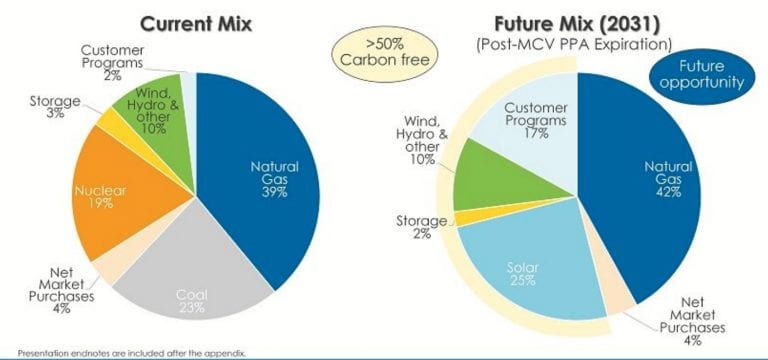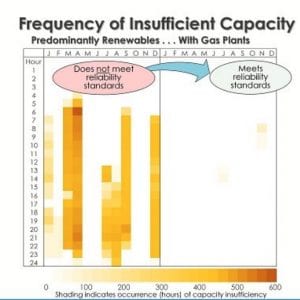In an updated integrated resource plan (IRP) filed with the Michigan Public Service Commission (MPSC) on June 23, the CMS Energy subsidiary said the effort would lead Michigan’s clean energy transformation, and, if approved, it would make Consumers “one of the first utilities in the nation to go coal-free.”
Under the sweeping plan, Consumers will accelerate the closure of about 2.5 GW by 2025. It will speed up retirement of its three coal-fired units at its Campbell generating complex near Holland to 2025. Campbell 1 and 2—a combined 600 MW—are currently slated to close in six years. The 840-MW Campbell 3 is scheduled to close in 2040. It would also speed up closure of D.E. Karn 3 and 4, peaking units with a total capacity of 1,119 MW that currently run on natural gas and fuel oil, to 2023, eight years sooner than their design lives.
Adding to Loss of Purchased Power from Palisades Nuclear Plant
The retirements are noteworthy for the 1886-founded utility, which serves about 1.9 million customers throughout the state. While not wholly unexpected—mainly because Consumers last year announced it would set out to achieve net-zero carbon emissions from its electric business by 2040—the company is already looking a substantial slate of near-term retirements.
In its February-filed annual financial report, CMS Energy outlined plans to retire the D.E. Karn 1 and 2 coal-fired units, a combined 460 MW, by 2023. While Consumers also currently buys 813 MW from Entergy’s single-unit Palisades nuclear plant in Van Buren County (Entergy bought the reactor from Consumers in 2007 for $380 million), Palisades will be permanently closed in the spring of 2022, well before its license expires in 2031.

The proposed 2021 IRP suggests that a total coal phase-out will reduce Consumers’ carbon emissions by 60% by 2025 compared to a 2005 baseline and add $1 billion of rate base over the next five years.
The company plans to replace that power with gas power from four existing natural gas plants it has proposed to acquire: the 1.2-GW Covert Generating Station in Van Buren County, which is currently owned by Eastern Generation; the 770-MW Dearborn Industrial Generation in Wayne County, which is owned by CMS Energy’s unregulated subsidiary CMS Enterprises; and the 73.5-MW Kalamazoo River Generating Station in Kalamazoo County and 156-MW Livingston Generating Station in Otsego County, which are also owned by CMS Enterprises. The Kalamazoo River and Livingston plants will primarily be used to meet peak demand.
These plants would add 2.2-GW to Consumers’ current 1.4-GW gas-fired portfolio, which currently includes the Zeeland and Jackson facilities. However, the proposed purchases will require state and federal regulatory approval, it noted.
The IRP also suggests Consumers will add 7,800 MW of solar by 2040 (including 4,500 MW by 2030), 800-MW wind by 2023, and 500 MW of battery storage by 2040 (beginning in 2030). The renewable resources should comprise more than 60% if its total electric capacity by 2040. “Combining that growth with advances in energy storage and customer efficiency will allow us to meet customers’ needs with 90% clean energy resources,” it said.

The solar ramp-up has already begun and will continue throughout the 2020s, it said. Consumers currently operates solar power plants at Western Michigan University, Grand Valley State University and in Cadillac and purchases solar generation from several sites in Michigan.
Additionally, the utility plans to save 1.1 GW in energy efficiency measures through customer programs through 2030. It also plans a “conservation voltage reduction” of more than 100 MW and establish about 750 MW in demand response over the next decade.
‘We Have Done This Before’
“We have done this before,” the utility said in its IRP presentation materials. In 2016, the company retired seven coal units in response to changing environmental regulations and market conditions that made it uneconomic to continue operating the plants.
Its plan to bank on natural gas as a source of baseload power rests on considerations that a “predominantly renewables scenario offers insufficient capacity to meet reliability standards—in the winter when solar energy is less abundant and in the summer,” it noted. “Gas plants provide flexibility to be dispatched as needed for long-duration needs (days or weeks).” It also noted buying existing plants with shorter lifetimes at a lower cost “reduces long-term risks.”

“Our plan creates price stability and, by using natural gas as a fuel source to generate baseload power, will save customers about $650 million through 2040 compared to our current plan,” Consumers said. “Further, the increased use of demand management tools such as energy waste reduction programs will give customers more control over their monthly energy bills, equipping them to save energy and money over the long term.”